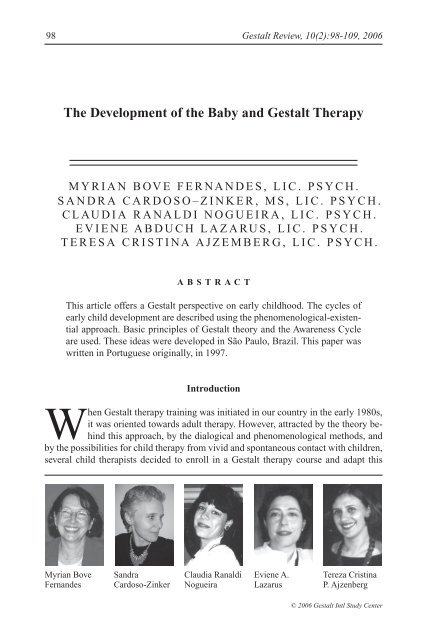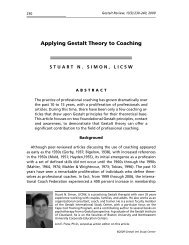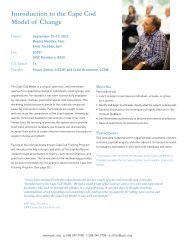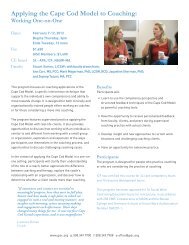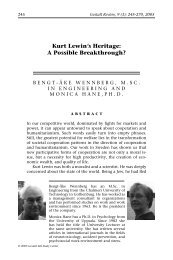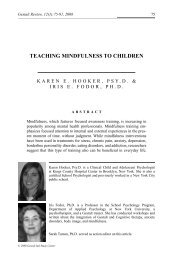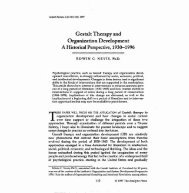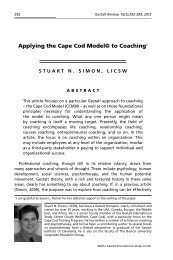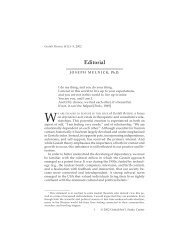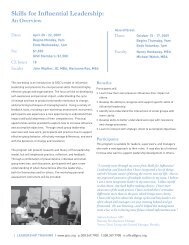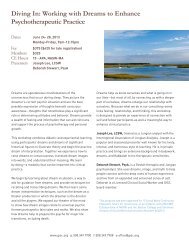The Development of the Baby and Gestalt Therapy
The Development of the Baby and Gestalt Therapy
The Development of the Baby and Gestalt Therapy
Create successful ePaper yourself
Turn your PDF publications into a flip-book with our unique Google optimized e-Paper software.
98<br />
<strong>Gestalt</strong> Review, 10(2):98-109, 2006<br />
<strong>The</strong> <strong>Development</strong> <strong>of</strong> <strong>the</strong> <strong>Baby</strong> <strong>and</strong> <strong>Gestalt</strong> <strong>The</strong>rapy<br />
M y r i a n B ov e F e r na n d e s , L i c . P s y c h .<br />
S a n d r a C a r d o s o – Z i n k e r , M S , L i c . P s y c h .<br />
C l au d i a R a na l d i N o g u e i r a , L i c . P s y c h .<br />
E v i e n e A b d u c h L a z a ru s , L i c . P s y c h .<br />
T e r e s a C r i s t i na A j z e m b e r g , L i c . P s y c h .<br />
A b s t r a c t<br />
This article <strong>of</strong>fers a <strong>Gestalt</strong> perspective on early childhood. <strong>The</strong> cycles <strong>of</strong><br />
early child development are described using <strong>the</strong> phenomenological-existential<br />
approach. Basic principles <strong>of</strong> <strong>Gestalt</strong> <strong>the</strong>ory <strong>and</strong> <strong>the</strong> Awareness Cycle<br />
are used. <strong>The</strong>se ideas were developed in São Paulo, Brazil. This paper was<br />
written in Portuguese originally, in 1997.<br />
Introduction<br />
When <strong>Gestalt</strong> <strong>the</strong>rapy training was initiated in our country in <strong>the</strong> early 1980s,<br />
it was oriented towards adult <strong>the</strong>rapy. However, attracted by <strong>the</strong> <strong>the</strong>ory behind<br />
this approach, by <strong>the</strong> dialogical <strong>and</strong> phenomenological methods, <strong>and</strong><br />
by <strong>the</strong> possibilities for child <strong>the</strong>rapy from vivid <strong>and</strong> spontaneous contact with children,<br />
several child <strong>the</strong>rapists decided to enroll in a <strong>Gestalt</strong> <strong>the</strong>rapy course <strong>and</strong> adapt this<br />
Myrian Bove<br />
Fern<strong>and</strong>es<br />
S<strong>and</strong>ra<br />
Cardoso-Zinker<br />
Claudia Ranaldi<br />
Nogueira<br />
Eviene A.<br />
Lazarus<br />
Tereza Cristina<br />
P. Ajzenberg<br />
© 2006 <strong>Gestalt</strong> Intl Study Center
fern<strong>and</strong>es, cardoso-zinker, nogueira, lazarus, ajzemberg<br />
99<br />
knowledge to <strong>the</strong>ir practice.<br />
This context provided <strong>the</strong> background in which a study group was created. We<br />
came toge<strong>the</strong>r to exchange experiences, doubts, <strong>and</strong> ideas related to <strong>the</strong>rapeutic work<br />
with children. Throughout <strong>the</strong>se years it has become clear to us that despite having<br />
embraced <strong>the</strong> methodology <strong>and</strong> <strong>the</strong>oretical framework <strong>of</strong> <strong>Gestalt</strong> <strong>the</strong>rapy, it has been<br />
impossible for us to overlook our backgrounds in child development which provide an<br />
essential basis for <strong>the</strong> comprehensive diagnosis required for <strong>the</strong>rapeutic interventions<br />
when working with children. We believe that <strong>the</strong> study <strong>of</strong> child development is fundamental<br />
for <strong>the</strong> work carried out by both child <strong>and</strong> adult <strong>the</strong>rapists.<br />
We do not pretend to be formulating a <strong>the</strong>ory <strong>of</strong> development, nor do we intend to<br />
present any conclusive results <strong>of</strong> scientific research; however, we would like to bring<br />
up <strong>the</strong> questions <strong>and</strong> discussions that we covered in our attempt to underst<strong>and</strong> child<br />
development from <strong>the</strong> bases <strong>of</strong> our knowledge <strong>and</strong> perspectives on <strong>Gestalt</strong> <strong>the</strong>rapy<br />
<strong>the</strong>ory.<br />
Basic Ideas<br />
We conceive <strong>of</strong> child development as circular <strong>and</strong> successive processes <strong>of</strong> creative<br />
adjustments that embody action <strong>and</strong> reaction, expansion <strong>and</strong> contraction, differentiation<br />
<strong>and</strong> abstraction, analysis <strong>and</strong> syn<strong>the</strong>sis, destruction <strong>and</strong> integration, <strong>and</strong> disorganization<br />
<strong>and</strong> reorganization.<br />
As experiences <strong>of</strong> contact are assimilated, <strong>the</strong>y create <strong>the</strong> structure <strong>of</strong> <strong>the</strong> self <strong>and</strong>, at<br />
<strong>the</strong> same time, <strong>the</strong>y are <strong>the</strong> support for new changes. We underst<strong>and</strong> self as described<br />
by Perls, Hefferline & Goodman (1951):<br />
[T]he complex system <strong>of</strong> contacts necessary for adjustment in <strong>the</strong> difficult<br />
field, we can call “self.” Self may be regarded as <strong>the</strong> boundary <strong>of</strong> <strong>the</strong><br />
Myrian Bove Fern<strong>and</strong>es specializes in clinical psychology <strong>and</strong> is coordinator <strong>and</strong> a member <strong>of</strong><br />
<strong>the</strong> board <strong>of</strong> trainers <strong>of</strong> <strong>the</strong> Instituto <strong>Gestalt</strong> de São Paulo, Brazil.<br />
S<strong>and</strong>ra Cardoso-Zinker, MS Lic, is a <strong>Gestalt</strong> psychologist from Brazil. She has taught <strong>Gestalt</strong><br />
<strong>the</strong>rapy in work with children <strong>and</strong> <strong>the</strong> arts, <strong>and</strong> has written articles about <strong>Gestalt</strong> <strong>the</strong>rapy in<br />
relation to human development <strong>and</strong> Attachment <strong>The</strong>ory. She teaches <strong>Gestalt</strong> Couples <strong>and</strong> Child<br />
<strong>The</strong>rapy in <strong>the</strong> U.S., Europe, <strong>and</strong> South America. She is affiliated with <strong>the</strong> <strong>Gestalt</strong> International<br />
Study Center <strong>and</strong> is a faculty member <strong>of</strong> <strong>The</strong> <strong>Gestalt</strong> Institute <strong>of</strong> São Paulo.<br />
Claudia Ranaldi Nogueira specializes in clinical psychology <strong>and</strong> is <strong>the</strong> coordinator <strong>of</strong> <strong>the</strong> <strong>Gestalt</strong><br />
Institute <strong>of</strong> São Paulo, Brazil. She is also a member <strong>of</strong> <strong>the</strong> board <strong>of</strong> trainers in <strong>the</strong> <strong>Gestalt</strong> Art<br />
<strong>The</strong>rapy at <strong>the</strong> Institute Sedes Sapientiae, São Paulo.<br />
Eviene A. Lazarus specializes in clinical psycho<strong>the</strong>rapy <strong>and</strong> is a member <strong>of</strong> <strong>the</strong> board <strong>of</strong> trainers<br />
<strong>of</strong> <strong>the</strong> <strong>Gestalt</strong> <strong>The</strong>rapy Training Program <strong>of</strong> Instituto Sedes Sapientiae <strong>and</strong> <strong>Gestalt</strong> Institute <strong>of</strong><br />
São Paulo.<br />
Tereza Cristina P. Ajzenberg specializes in clinical psycho<strong>the</strong>rapy <strong>and</strong> is a member <strong>of</strong> <strong>the</strong> board<br />
<strong>of</strong> trainers in <strong>the</strong> <strong>Gestalt</strong> Art <strong>The</strong>rapy Course <strong>of</strong> Instituto Sedes Sapientiae <strong>and</strong> <strong>of</strong> <strong>the</strong> <strong>Gestalt</strong><br />
<strong>The</strong>rapy Training Program <strong>of</strong> <strong>Gestalt</strong> Institute <strong>of</strong> São Paulo.
100<br />
<strong>the</strong> development <strong>of</strong> <strong>the</strong> baby<br />
organism, but <strong>the</strong> boundary is not itself isolated from <strong>the</strong> environment; it<br />
belongs to both, environment <strong>and</strong> organism. Contact is to touch something.<br />
<strong>The</strong> self is not to be thought as a fixed institution, it exists wherever <strong>and</strong><br />
whenever <strong>the</strong>re is in fact a boundary interaction [p. 151].<br />
For instance, <strong>the</strong>se interactions, or contact episodes, between mo<strong>the</strong>r <strong>and</strong> baby are<br />
developed through orderly processes that lead to <strong>the</strong> configuration <strong>of</strong> specific patterns.<br />
At any moment, however, a disturbance can take place bringing unforeseen, unexpected<br />
events. <strong>The</strong> existing patterns will change. Some patterns will cross over, o<strong>the</strong>rs<br />
will become crystallized, <strong>and</strong> still o<strong>the</strong>rs will dissolve, allowing <strong>the</strong> configuration <strong>of</strong><br />
new patterns. <strong>The</strong>se patterns will recur successively.<br />
If we think about child development as a process <strong>of</strong> differentiated opposite aspects<br />
in <strong>the</strong> contact field <strong>and</strong> how <strong>the</strong>y relate to each o<strong>the</strong>r (for instance: cold <strong>and</strong> hot, pain<br />
<strong>and</strong> pleasure, tension <strong>and</strong> relaxation, etc.), we can also underst<strong>and</strong> why a person has<br />
complex “facets.” It is as if life could be represented by a kaleidoscope, in which<br />
simple but different forms create <strong>and</strong> re-create figures that don’t repeat <strong>the</strong>mselves.<br />
This metaphor demonstrates how complex <strong>the</strong> process <strong>of</strong> human development is. And,<br />
owing to this complexity, it is difficult to describe all <strong>the</strong> possibilities <strong>of</strong> contact experiences<br />
once we assume that <strong>the</strong>re are no limits to <strong>the</strong>m in <strong>the</strong> experiential world.<br />
We can say that differentiation <strong>and</strong> integration are processes present in <strong>the</strong> assimilation<br />
<strong>of</strong> experiences, <strong>and</strong> that this assimilation <strong>of</strong> experiences provides <strong>the</strong> support for<br />
new differentiation <strong>and</strong> integration. For example, a baby is sleeping in his crib, alone<br />
in his bedroom. He wakes up in a silent room. He moves his body <strong>and</strong> starts making<br />
some vocal sounds. His mo<strong>the</strong>r comes into <strong>the</strong> room <strong>and</strong> talks to him. She takes him<br />
in her arms for some minutes, puts him back into <strong>the</strong> crib, <strong>and</strong> leaves <strong>the</strong> room. <strong>The</strong><br />
room is silent again. <strong>The</strong> baby is moving rapidly <strong>and</strong> starts crying. Mo<strong>the</strong>r takes him in<br />
her arms for ano<strong>the</strong>r couple <strong>of</strong> minutes <strong>and</strong> puts him back into <strong>the</strong> crib. <strong>The</strong> baby starts<br />
crying <strong>the</strong> moment <strong>the</strong> mo<strong>the</strong>r lays him down again. She picks him up <strong>and</strong> leaves <strong>the</strong><br />
room with <strong>the</strong> baby in her arms. We can say that <strong>the</strong> baby is experiencing crying as an<br />
opportunity for attention <strong>and</strong> <strong>the</strong> mo<strong>the</strong>r is in <strong>the</strong> process <strong>of</strong> making a meaning <strong>of</strong> her<br />
baby’s discomfort.<br />
<strong>The</strong> dynamic organization <strong>and</strong> reorganization <strong>of</strong> <strong>the</strong>se patterns, coupled with exp<strong>and</strong>ing<br />
awareness, will favor a new expansion <strong>of</strong> boundaries. Growth will take place<br />
during <strong>the</strong> process <strong>of</strong> identity construction. <strong>Development</strong> occurs as a dance-like movement<br />
<strong>and</strong> as noted by Perls, Hefferline & Goodman, (1951):<br />
[T]he field as a whole tends to complete itself, to reach <strong>the</strong> simplest equilibrium<br />
possible for that level <strong>of</strong> field. But, since <strong>the</strong> conditions are always<br />
changing, <strong>the</strong> partial equilibrium achieved is always novel; it must be<br />
“grown to.” An organism is only by growing. Self-preserving <strong>and</strong> growing<br />
are polar, for it is only what continually assimilates novelty that can preserve<br />
itself <strong>and</strong> not degenerate. So <strong>the</strong> materials <strong>and</strong> energy <strong>of</strong> growth are:<br />
<strong>the</strong> conservative attempt <strong>of</strong> <strong>the</strong> organism to remain as it has been, <strong>the</strong> novel
fern<strong>and</strong>es, cardoso-zinker, nogueira, lazarus, ajzemberg<br />
101<br />
environment, <strong>the</strong> destruction <strong>of</strong> previous partial equilibrium, <strong>and</strong> assimilation<br />
<strong>of</strong> something new. [p. 151].<br />
Again, <strong>the</strong>y note that “we can interpret this growth to responsibility, again, as organism-self-regulation<br />
in a changing field” (p. 80).<br />
<strong>The</strong> <strong>Development</strong> <strong>of</strong> <strong>the</strong> <strong>Baby</strong><br />
Even before conception, <strong>the</strong> child’s parents have constructed beliefs, dreams, aspirations,<br />
fantasies, <strong>and</strong> ideas during <strong>the</strong> course <strong>of</strong> <strong>the</strong>ir lives about how to be a fa<strong>the</strong>r or<br />
a mo<strong>the</strong>r. All <strong>the</strong> experiences, which refer back to <strong>the</strong>ir relationships with <strong>the</strong>ir own<br />
parents, will turn into a system <strong>of</strong> beliefs that will influence <strong>the</strong>ir choices <strong>and</strong> attitudes<br />
in raising <strong>the</strong>ir children. We are emphasizing <strong>the</strong> personal mythology <strong>of</strong> each member<br />
<strong>of</strong> <strong>the</strong> couple, who brings with him/her <strong>the</strong> myth <strong>of</strong> his/her family <strong>of</strong> origin. When <strong>the</strong><br />
two people meet, <strong>the</strong>y develop specific dynamics in <strong>the</strong>ir relationship that depend on<br />
<strong>the</strong> resources <strong>the</strong>y have <strong>and</strong> on <strong>the</strong> creative adjustments <strong>the</strong>y must make to start <strong>the</strong>ir<br />
new family. (See Ciornai, 1995 in reference to <strong>the</strong> work <strong>of</strong> Feinstein <strong>and</strong> Krippner.)<br />
<strong>The</strong>refore, we may ask:<br />
• What is <strong>the</strong> meaning <strong>of</strong> this child’s arrival to <strong>the</strong> mo<strong>the</strong>r <strong>and</strong> fa<strong>the</strong>r?<br />
• At what moment in <strong>the</strong> personal history <strong>of</strong> each parent, <strong>and</strong> <strong>the</strong> family, is this child<br />
conceived?<br />
• What role does this child fulfill? Does she or he stabilize or destabilize a relationship?<br />
Fill in gaps, or hold a relationship toge<strong>the</strong>r?<br />
• What are <strong>the</strong> parents’ desires <strong>and</strong> expectations regarding this child? Will <strong>the</strong> child<br />
fulfill <strong>the</strong> dreams that <strong>the</strong> parents <strong>the</strong>mselves didn’t fulfill?<br />
• What are <strong>the</strong> apprehensions <strong>the</strong>y have regarding <strong>the</strong> arrival <strong>of</strong> this child? Will <strong>the</strong><br />
baby require a lot <strong>of</strong> work? Could this affect <strong>the</strong>ir projects as individuals <strong>and</strong> as a<br />
couple?<br />
In short, <strong>the</strong>re are many possibilities regarding <strong>the</strong> anticipation <strong>of</strong> <strong>the</strong> baby’s arrival.<br />
Within this field, <strong>the</strong> parent/child interaction will develop during <strong>the</strong> period that starts<br />
with conception <strong>and</strong> continues throughout pregnancy.<br />
It should be kept in mind that <strong>the</strong> process <strong>of</strong> hereditary transmission is highly r<strong>and</strong>om,<br />
which means that except for identical twins (<strong>and</strong> clones!), each human being is<br />
genetically unique <strong>and</strong> biologically different from ano<strong>the</strong>r being.<br />
<strong>The</strong> moment <strong>the</strong> egg is fixed in <strong>the</strong> uterus wall, <strong>the</strong> growth process <strong>of</strong> a new being<br />
starts <strong>and</strong> is supported through <strong>the</strong> interaction with <strong>the</strong> mo<strong>the</strong>r. During this period,<br />
circular changes occur. Changes in <strong>the</strong> fetus influence <strong>the</strong> way <strong>the</strong> mo<strong>the</strong>r feels <strong>and</strong><br />
perceives her baby, <strong>and</strong> <strong>the</strong>n reorganizes herself according to her new sensations. On<br />
<strong>the</strong> o<strong>the</strong>r h<strong>and</strong>, <strong>the</strong> fetus is accommodating him/herself inside <strong>the</strong> uterus <strong>and</strong> is influenced<br />
by <strong>the</strong> emotional <strong>and</strong> organic state that <strong>the</strong> mo<strong>the</strong>r is experiencing.<br />
In conception, <strong>the</strong> embryo provokes hormonal <strong>and</strong> biochemical changes in <strong>the</strong><br />
woman’s body, which undergoes some difficult transformations such as breast rigidity,<br />
nausea, sleepiness, <strong>and</strong> so on. Emotional <strong>and</strong> organism reorganization <strong>of</strong>ten includes
102<br />
<strong>the</strong> development <strong>of</strong> <strong>the</strong> baby<br />
fantasies <strong>and</strong> anxiety. <strong>The</strong> woman’s body is constantly adjusting in order to welcome<br />
<strong>the</strong> new human being that is taking more space <strong>and</strong> becoming more <strong>and</strong> more present<br />
inside her.<br />
First Interactions<br />
During <strong>the</strong> pregnancy, it is <strong>the</strong> mo<strong>the</strong>r who mediates exchanges between <strong>the</strong> fetus<br />
<strong>and</strong> <strong>the</strong> outside world. <strong>The</strong>se exchanges take place on both physical (hormonal changes)<br />
<strong>and</strong> behavioral (talking with <strong>the</strong> baby) levels. <strong>The</strong> way <strong>the</strong> mo<strong>the</strong>r is experiencing<br />
<strong>the</strong> exchange with <strong>the</strong> environment also will influence <strong>the</strong> fetus.<br />
As <strong>the</strong> fetus receives nutrition, <strong>the</strong> cells multiply, <strong>and</strong> organs continue <strong>the</strong> process <strong>of</strong><br />
differentiation <strong>and</strong> functional organization. Sensory <strong>and</strong> motor functions are developing<br />
at <strong>the</strong> same time. Research (Wilheim, 1992) demonstrates that <strong>the</strong> intrauterine<br />
environment is not as calm <strong>and</strong> quiet as we might suppose. <strong>The</strong> combined internal<br />
noises <strong>of</strong> <strong>the</strong> mo<strong>the</strong>r’s body, such as cardiac beats, intestinal sounds, <strong>and</strong> blood streaming,<br />
produce sounds equivalent to urban traffic. <strong>The</strong> fetus senses <strong>and</strong> reacts to light <strong>and</strong><br />
sounds from <strong>the</strong> external environment.<br />
We are assuming that <strong>the</strong> mo<strong>the</strong>r/fa<strong>the</strong>r/baby contact boundary is narrowly linked<br />
to <strong>the</strong> quality <strong>of</strong> <strong>the</strong> contact established by <strong>the</strong> fetus with his or her environment; that<br />
is, <strong>the</strong> fetus’s ability to receive stimuli. So we believe that if <strong>the</strong> mo<strong>the</strong>r’s boundary is<br />
sufficiently strong to filter <strong>and</strong> select <strong>the</strong> stimuli that affect her, <strong>and</strong> at <strong>the</strong> same time<br />
is sufficiently permeable to permit new stimuli to affect her, <strong>the</strong> fetus will <strong>the</strong>n be<br />
receptive to new situations that favor his or her growth, while being protected against<br />
invasions <strong>of</strong> stimuli that are potentially toxic.<br />
If <strong>the</strong> mo<strong>the</strong>r’s boundary is weaker, <strong>the</strong> fetus will be subject to additional invasions,<br />
<strong>and</strong> disagreeable sensations may occur <strong>and</strong> somehow register. We assume that if, on<br />
<strong>the</strong> contrary, <strong>the</strong> mo<strong>the</strong>r’s boundary is extremely rigid <strong>and</strong> impenetrable, <strong>the</strong> fetus will<br />
be protected by a barrier that may isolate him or her from <strong>the</strong> environment, thus suffocating<br />
or severely limiting growth.<br />
Recent studies by Wilheim (1992) assert that <strong>the</strong> baby is not a passive receiver <strong>of</strong><br />
external stimuli, but ra<strong>the</strong>r a being that constructs himself or herself with his or her<br />
own characteristics during <strong>the</strong> months <strong>of</strong> intrauterine life, through interaction with<br />
<strong>the</strong> mo<strong>the</strong>r. Well before birth, <strong>the</strong> fetus perceives sound <strong>and</strong> light; she/he is capable<br />
<strong>of</strong> swallowing, tasting, reacting to bitter substances, making faces, smiling, dreaming,<br />
choosing favorite positions, recognizing <strong>the</strong> mo<strong>the</strong>r’s voice, playing with <strong>the</strong> umbilical<br />
cord, reacting when stimulated, <strong>and</strong> showing intelligent behavior. We believe that <strong>the</strong>se<br />
behaviors are linked to <strong>the</strong> ability to adapt <strong>and</strong> conform to new situations, <strong>and</strong> to select<br />
conditions <strong>and</strong> pr<strong>of</strong>it from experiences—all <strong>of</strong> which imply learning <strong>and</strong> memory. We<br />
can also say that <strong>the</strong> first creative adjustments already exist in this phase. We illustrate<br />
this statement by referring to experiments reported by Wilheim (1992), in which pregnant<br />
women read <strong>the</strong> same story aloud to <strong>the</strong>ir babies twice a day. Three days after <strong>the</strong><br />
babies’ birth, when <strong>the</strong> mo<strong>the</strong>rs read <strong>the</strong> same story <strong>and</strong> ano<strong>the</strong>r story aloud to <strong>the</strong>ir<br />
babies, <strong>the</strong>y observed that <strong>the</strong> babies showed evident preferences for <strong>the</strong> story that was<br />
already known by sucking more frequently while it was read. <strong>The</strong> same experiments
fern<strong>and</strong>es, cardoso-zinker, nogueira, lazarus, ajzemberg<br />
103<br />
also were made using music <strong>and</strong> maternal <strong>and</strong> paternal voices. <strong>The</strong>y yielded <strong>the</strong> same<br />
outcome.<br />
Since <strong>the</strong> sensory organs <strong>and</strong> motor functions <strong>of</strong> <strong>the</strong> fetus have already developed,<br />
she/he is ready to be in contact after receiving stimuli. However, maturation <strong>of</strong> <strong>the</strong><br />
central nervous system at this point permits only <strong>the</strong> subcortical structures (reptilian<br />
<strong>and</strong> limbic brain) to function. <strong>The</strong> neocortex is not yet developed enough to be able to<br />
perform <strong>the</strong> cognitive activity necessary for establishing relationships <strong>and</strong> accurately<br />
comprehending phenomena that occur at <strong>the</strong> boundary. Never<strong>the</strong>less, <strong>the</strong> fetus shows<br />
responses that are appropriate relative to its biological maturity.<br />
Contact During Pregnancy<br />
We believe contact is made via energetic sensory-motor support, although at a<br />
primitive level. A specific dynamic is characterized this way: Sensations emerge <strong>and</strong><br />
are interwoven by movement <strong>and</strong> withdrawal. <strong>The</strong> fetus promptly mobilizes energy,<br />
emits a motor response, <strong>and</strong> retracts as a newborn might. Let us imagine, for example,<br />
a mo<strong>the</strong>r changing <strong>the</strong> diapers <strong>of</strong> her two-month-old daughter. She is holding her legs<br />
up <strong>and</strong> talking to <strong>the</strong> baby while she cleans her body. Mo<strong>the</strong>r puts baby’s legs down on<br />
<strong>the</strong> bed <strong>and</strong> fastens <strong>the</strong> diaper. <strong>The</strong> baby moves her arms <strong>and</strong> head, following different<br />
stimuli in <strong>the</strong> room with her eyes. As <strong>the</strong> mo<strong>the</strong>r dresses her, <strong>the</strong> baby starts making<br />
some sounds. <strong>The</strong> mo<strong>the</strong>r responds by talking to her, but <strong>the</strong> baby’s sounds are getting<br />
louder. Mo<strong>the</strong>r continues talking <strong>and</strong> starts cleaning <strong>the</strong> baby’s ears. <strong>The</strong> baby moves<br />
her head faster, from right to left, <strong>and</strong> also starts moving her upper body <strong>and</strong> legs. She<br />
is now crying.<br />
<strong>The</strong> mo<strong>the</strong>r promptly stops <strong>the</strong> task <strong>and</strong> takes <strong>the</strong> baby girl in her arms saying:<br />
“Okay, it is time to eat now.”<br />
We underst<strong>and</strong> that this dynamic is a process <strong>of</strong> contact, <strong>and</strong> we can question whe<strong>the</strong>r<br />
<strong>the</strong>re is any awareness on <strong>the</strong> part <strong>of</strong> <strong>the</strong> baby. Perhaps <strong>the</strong>re may be “awareness,”<br />
although primitive at this point. Once <strong>the</strong> sensation is experienced <strong>and</strong> in some way<br />
registered, this vivid experience is appropriated by both <strong>the</strong> baby <strong>and</strong> <strong>the</strong> mo<strong>the</strong>r. <strong>The</strong><br />
mo<strong>the</strong>r interacts with <strong>the</strong> baby <strong>and</strong> helps to give meaning to <strong>the</strong> sensorial expression<br />
<strong>of</strong> her baby daughter.<br />
Perls, Hefferline, <strong>and</strong> Goodman (1951) assert: “Presumably, <strong>the</strong>re are no primitive<br />
organisms in which awareness <strong>and</strong> motor response are <strong>the</strong> same act; <strong>and</strong> in organisms<br />
<strong>of</strong> higher grade, where <strong>the</strong>re is good contact, one can always show <strong>the</strong> cooperation <strong>of</strong><br />
sense <strong>and</strong> movement (<strong>and</strong> also feeling)” (p. 4).<br />
We can assume that during human development in <strong>the</strong> womb, <strong>the</strong>re already is differentiation,<br />
even if it is subtle, among sensation, perception, <strong>and</strong> motor response.<br />
However, if we use <strong>the</strong> definition provided by Joseph Zinker (1997), <strong>the</strong>re is still no<br />
awareness in <strong>the</strong> fetus. According to Zinker, awareness refers to <strong>the</strong> ability to reflect,<br />
before moving to action, <strong>and</strong> also to mentally exhaust all <strong>the</strong> possibilities for action:<br />
Awareness, <strong>the</strong>refore, allows me to underst<strong>and</strong> what my body needs at this<br />
point in time... Awareness is a blessing because it enables me to under-
104<br />
<strong>the</strong> development <strong>of</strong> <strong>the</strong> baby<br />
st<strong>and</strong> what is going on inside, <strong>and</strong> what I can do to make myself feel better<br />
[p. 90].<br />
Keeping in mind <strong>the</strong> description given by Perls, Hefferline, <strong>and</strong> Goodman (1951), we<br />
can infer that <strong>the</strong> fetus <strong>and</strong> <strong>the</strong> newborn baby display a primitive sensorial “awareness”<br />
(can we call it fetal “awareness?”). We could say that in <strong>the</strong> awareness–excitementcontact<br />
cycle described by Zinker (1997), <strong>the</strong> baby may go from sensation directly to<br />
action, skipping over <strong>the</strong> perceptual naming phase <strong>of</strong> <strong>the</strong> experience. This action will<br />
result in contact <strong>and</strong> retraction.<br />
<strong>The</strong>oretically, <strong>the</strong>refore, before birth <strong>the</strong> baby is an “intelligent,” sensitive being<br />
who exhibits unique personality traits. <strong>The</strong> fetus has an emotional life that is linked to<br />
<strong>the</strong> mo<strong>the</strong>r. <strong>The</strong> baby may well be in empathic communication with her, sensing her<br />
emotional condition <strong>and</strong> her affective availability in relation to himself or herself.<br />
We assume that throughout intrauterine life, this internal environment is consonant<br />
with <strong>the</strong> environment that <strong>the</strong> baby will find after birth. <strong>The</strong>re is a continuity between<br />
intrauterine life <strong>and</strong> life after birth. Characteristics present in <strong>the</strong> intrauterine life will<br />
be fur<strong>the</strong>r enhanced as <strong>the</strong> baby grows. In this period, <strong>the</strong> baby will register his or her<br />
experience <strong>and</strong>, after birth, will have assimilated this process as self-support for future<br />
interaction.<br />
When <strong>the</strong> <strong>Baby</strong> Is Born<br />
Immediately after birth, <strong>the</strong> baby is ready to interact. Mo<strong>the</strong>r <strong>and</strong> child are active at<br />
<strong>the</strong> moment <strong>of</strong> birth. <strong>The</strong>re is a sudden change in <strong>the</strong> field, <strong>and</strong> new behavior patterns<br />
are required from <strong>the</strong> mo<strong>the</strong>r, <strong>the</strong> child, <strong>and</strong> <strong>the</strong> family. While <strong>the</strong> baby is inside <strong>the</strong><br />
womb, mo<strong>the</strong>r <strong>and</strong> baby experience <strong>the</strong> field in different ways. For example, sounds<br />
that <strong>the</strong> baby hears are different from <strong>the</strong> ones <strong>the</strong> mo<strong>the</strong>r hears; <strong>the</strong> baby lives in a<br />
liquid environment, while <strong>the</strong> mo<strong>the</strong>r uses <strong>the</strong> respiratory system to survive. At birth,<br />
<strong>the</strong> baby becomes part <strong>of</strong> <strong>the</strong> same environment <strong>and</strong> a process <strong>of</strong> contact boundary<br />
reorganization takes place.<br />
Depending on how <strong>the</strong> arrival <strong>of</strong> this new being affects its parents’ field, <strong>the</strong> parents<br />
will feel different emotions. Many mo<strong>the</strong>rs <strong>and</strong> fa<strong>the</strong>rs enjoy <strong>and</strong> warmly embrace<br />
contact with <strong>the</strong>ir baby, while o<strong>the</strong>rs may feel invaded <strong>and</strong> cannot reorganize <strong>the</strong>mselves<br />
promptly in <strong>the</strong> new situation. Some mo<strong>the</strong>rs <strong>and</strong> fa<strong>the</strong>rs may go through postpartum<br />
depression, <strong>and</strong> will withdraw from <strong>the</strong> baby. Many conflicts may occur <strong>and</strong><br />
be influenced by economic <strong>and</strong> social conditions. Regardless <strong>of</strong> <strong>the</strong> mo<strong>the</strong>r’s reaction,<br />
however, it is expected that she will be <strong>the</strong> figure with whom <strong>the</strong> baby will be in contact<br />
more intensively. This child, who still grasps <strong>the</strong> world in a very sensory manner, will<br />
assimilate <strong>and</strong> memorize his or her sensations primarily in <strong>the</strong> contact with <strong>the</strong> mo<strong>the</strong>r,<br />
fa<strong>the</strong>r, caretaker, <strong>and</strong> surrounding people.<br />
<strong>The</strong> baby is extremely competent in attracting <strong>the</strong> parents, who normally are enchanted.<br />
For example, <strong>the</strong> fa<strong>the</strong>r is sitting on a chair, his son is four months old <strong>and</strong> <strong>the</strong><br />
fa<strong>the</strong>r is feeding him. He is using his left arm to support <strong>the</strong> baby’s upper body, neck,<br />
<strong>and</strong> head. His arm envelops <strong>the</strong> baby’s little body <strong>and</strong> his left h<strong>and</strong> touches <strong>the</strong> baby’s
fern<strong>and</strong>es, cardoso-zinker, nogueira, lazarus, ajzemberg<br />
105<br />
belly. <strong>The</strong> fa<strong>the</strong>r is holding <strong>the</strong> bottle with his right h<strong>and</strong>. <strong>The</strong> baby’s body is still; his<br />
eyes are wide open, looking at his fa<strong>the</strong>r’s face. <strong>The</strong> baby’s left h<strong>and</strong> is touching one<br />
finger in <strong>the</strong> fa<strong>the</strong>r’s h<strong>and</strong>. <strong>The</strong> fa<strong>the</strong>r is looking at <strong>the</strong> son’s face, smiling <strong>and</strong>, at <strong>the</strong><br />
same time, moving his finger, gently caressing his son’s small h<strong>and</strong>s. <strong>The</strong> baby blinks<br />
from time to time, staying still, looking straight into his fa<strong>the</strong>r’s eyes. <strong>The</strong> fa<strong>the</strong>r has<br />
all his attention focused on <strong>the</strong> baby.<br />
Marshall <strong>and</strong> Phyllis Klauss (1989) assert that newborn infants prefer high-pitched<br />
voices, especially <strong>the</strong> mo<strong>the</strong>r’s. <strong>The</strong>y already move toward sounds, since <strong>the</strong> nerves<br />
that link hearing <strong>and</strong> vision have already developed. <strong>The</strong>refore, <strong>the</strong>y coordinate vision,<br />
sound, <strong>and</strong> <strong>the</strong> memory <strong>of</strong> <strong>the</strong>ir mo<strong>the</strong>r’s voice from <strong>the</strong> first weeks <strong>of</strong> life. One<br />
can infer that this movement is an adaptive response which insures <strong>the</strong> possibility <strong>of</strong><br />
experiencing contact.<br />
Babies perform contact functions. <strong>The</strong>re is no specifically right way to interact<br />
with <strong>the</strong>m. <strong>The</strong>ir visual capabilities, <strong>and</strong> <strong>the</strong>ir parents’ desire to admire <strong>the</strong>m, create<br />
infinite opportunities for <strong>the</strong>m to experience, discover, <strong>and</strong> interact with each o<strong>the</strong>r.<br />
Tuned into <strong>the</strong>ir babies, parents soon learn what interests <strong>and</strong> what annoys <strong>the</strong> child.<br />
Although many <strong>of</strong> <strong>the</strong> newborn’s responses infant are called “reflexes,” infants move<br />
to <strong>the</strong> rhythm <strong>of</strong> <strong>the</strong> mo<strong>the</strong>r’s voice, performing a kind <strong>of</strong> dance while <strong>the</strong>ir mo<strong>the</strong>r<br />
is talking. <strong>The</strong> authors believe that in some way <strong>the</strong> babies’ bodies are prepared to<br />
respond to human language <strong>and</strong> to “talk” much earlier than <strong>the</strong>y can actually formulate<br />
words. Daniel Stern asserts:<br />
Choreography <strong>of</strong> maternal behavior is <strong>the</strong> raw material from <strong>the</strong> outside<br />
world with which <strong>the</strong> baby starts to construct his knowledge <strong>and</strong> his experience<br />
<strong>of</strong> everything that is human—<strong>the</strong> forms <strong>and</strong> modifications, <strong>the</strong> expressions,<br />
units <strong>and</strong> meanings <strong>of</strong> behavior, <strong>the</strong> relationship between <strong>the</strong> baby’s<br />
own behavior <strong>and</strong> that <strong>of</strong> ano<strong>the</strong>r person [p. 15].<br />
One could say that <strong>the</strong> mo<strong>the</strong>r/baby field forms <strong>the</strong> matrix for social development.<br />
During daily activities, mo<strong>the</strong>r <strong>and</strong> baby will weave a dialogue: baby talk. For instance,<br />
a cry or a smile from <strong>the</strong> baby when taking a bath or when diapers are being changed<br />
will result in a response from <strong>the</strong> mo<strong>the</strong>r, who will interact <strong>and</strong> organize her responses<br />
within a pattern (she will talk in a “regressive way,” in a falsetto voice, leaving spaces<br />
between phrases, pausing before continuing <strong>the</strong> “dialogue”—as if <strong>the</strong> baby were really<br />
answering—making faces, expressing feigned surprise; in short, using expressions that<br />
are exaggerated in time <strong>and</strong> space). <strong>The</strong> child imitates <strong>the</strong> mo<strong>the</strong>r’s gestures, grimaces,<br />
<strong>and</strong> sounds, <strong>and</strong> enhances <strong>the</strong>se responses by experimentation.<br />
A choreography is thus formed, impregnated with emotion <strong>and</strong> affection. A meaning<br />
is gradually constructed for mo<strong>the</strong>r <strong>and</strong> child that is associated with each behavior.<br />
If, initially, <strong>the</strong> baby’s behaviors <strong>of</strong> looking, smiling, <strong>and</strong> crying are endogenous, <strong>the</strong>y<br />
will be transformed by successive interactions with <strong>the</strong> mo<strong>the</strong>r. <strong>The</strong> child starts to<br />
establish his or her first significant relationship, displaying intention in <strong>the</strong> responses<br />
(smiling to approach, <strong>and</strong> turning his face away from <strong>the</strong> mo<strong>the</strong>r, probably when he<br />
wants to withdraw from contact). He or she is learning <strong>the</strong> social communication code
106<br />
<strong>the</strong> development <strong>of</strong> <strong>the</strong> baby<br />
<strong>and</strong>, little by little, will form an individual interactive repertoire.<br />
Interaction <strong>and</strong> Dialogue<br />
<strong>The</strong> mo<strong>the</strong>r is present in this relationship not only with her contact channels attuned<br />
to perceiving <strong>the</strong> baby, but also with her cognitive skills which allow her to decode her<br />
child’s needs <strong>and</strong> respond to <strong>the</strong>m adequately. We believe that in this relationship, she<br />
is organizing <strong>the</strong> environmental stimuli for <strong>the</strong> baby. By selecting stimuli, associating<br />
emotions with facial <strong>and</strong> body expressions, <strong>and</strong> creating a daily routine in dealing with<br />
her baby, she helps <strong>the</strong> child form clear perceptions. <strong>The</strong> perceptions are assimilated<br />
by <strong>the</strong> baby <strong>and</strong> become part <strong>of</strong> his/her self-support.<br />
Within this child/environment intersection, <strong>the</strong> mo<strong>the</strong>r plays a double role: creating<br />
an environment in tune with <strong>the</strong> baby’s needs, <strong>and</strong> creating an environment that is in<br />
sync with <strong>the</strong> socio-cultural field in which this child will be raised. Thus, <strong>the</strong> baby will<br />
be able to learn communication codes, <strong>and</strong> to deal with limits <strong>and</strong> frustrations; that is,<br />
<strong>the</strong> child will learn to live under <strong>the</strong> law <strong>and</strong> rules established by <strong>the</strong> family <strong>and</strong> society,<br />
create defenses to deal with difficult situations, develop curiosity, invest knowledge,<br />
<strong>and</strong> so on.<br />
Experiencing “no” also allows a child to perceive o<strong>the</strong>rs. Children who are faced<br />
with a limit learn to establish boundaries between <strong>the</strong>mselves <strong>and</strong> o<strong>the</strong>rs. <strong>The</strong> child<br />
thus starts forming a notion about himself/herself as someone who feels, desires, <strong>and</strong><br />
behaves differently from o<strong>the</strong>rs.<br />
<strong>The</strong>oretically, one can state that when saying “no” to <strong>the</strong> child, <strong>the</strong> mo<strong>the</strong>r interrupts<br />
<strong>the</strong> cycle <strong>of</strong> contact performed by <strong>the</strong> child at <strong>the</strong> moment <strong>of</strong> transition between<br />
energy mobilization <strong>and</strong> action. Prevented from completing this cycle, <strong>the</strong> child can<br />
ei<strong>the</strong>r reinvest this energy, subsequently applying it to <strong>the</strong> same figure, or hold back<br />
this energy, reinvesting it in himself. For example, <strong>the</strong> child bangs his head on <strong>the</strong><br />
floor, pulling his own hair. Or he may block this energy, <strong>and</strong> hold it back, thus learning<br />
to temporarily delay satisfaction. Perhaps <strong>the</strong> child can reinvest this energy at a more<br />
favorable moment. <strong>The</strong>refore, <strong>the</strong> child will be developing what is called “frustration<br />
tolerance.” She/he will be dealing with disappointment. <strong>The</strong> child will be making creative<br />
adjustments <strong>and</strong> will construct a behavioral pattern. This pattern will become <strong>the</strong><br />
child’s personal style when dealing with similar situations.<br />
Becoming Part <strong>of</strong> <strong>the</strong> World<br />
<strong>The</strong> creative adjustment in this process is derived from both <strong>the</strong> inclination to tend<br />
to <strong>the</strong> child’s own needs, <strong>and</strong> from <strong>the</strong> emotional consequences brought about by <strong>the</strong><br />
child’s perception <strong>of</strong> how his or her actions affect people <strong>and</strong> <strong>the</strong> non-human environment.<br />
For example, a mo<strong>the</strong>r is breast-feeding her six-month-old son. She is sitting on a<br />
comfortable chair <strong>and</strong> has a pillow on her lap on which <strong>the</strong> baby lay, mostly with his<br />
upper body. <strong>The</strong> pillow supports his head <strong>and</strong> <strong>the</strong> mo<strong>the</strong>r has her left arm under <strong>the</strong><br />
pillow. When he starts sucking her breast, <strong>the</strong> mo<strong>the</strong>r’s sister enters <strong>the</strong> room <strong>and</strong> <strong>the</strong>y
fern<strong>and</strong>es, cardoso-zinker, nogueira, lazarus, ajzemberg<br />
107<br />
start talking to each o<strong>the</strong>r. <strong>The</strong> baby is looking at his mo<strong>the</strong>r’s face while she is talking<br />
to her sister. <strong>The</strong> baby starts making sounds. <strong>The</strong> mo<strong>the</strong>r looks at him, <strong>and</strong> touches his<br />
arms <strong>and</strong> legs while talking to her sister. <strong>The</strong> baby boy continues sucking her breasts,<br />
looking at her face <strong>and</strong> making more sounds. <strong>The</strong> mo<strong>the</strong>r looks at him for a second<br />
<strong>and</strong> turns to her sister again. In <strong>the</strong> next minute, <strong>the</strong> baby moves away from <strong>the</strong> breast<br />
<strong>and</strong> makes very loud sounds. Mo<strong>the</strong>r stops talking. <strong>The</strong> baby’s body <strong>and</strong> face are tense.<br />
Mo<strong>the</strong>r looks surprised. Her sister decides to leave <strong>the</strong> room. <strong>The</strong> mo<strong>the</strong>r agrees <strong>and</strong> is<br />
now silently looking at her son. He comes back to her breast <strong>and</strong> starts sucking again.<br />
From <strong>the</strong> child’s numerous experiences <strong>of</strong> his relationship to his world (such as frustration,<br />
love, potential realization, <strong>and</strong> many o<strong>the</strong>rs) which are recorded in his memory,<br />
he will begin to have a representation <strong>of</strong> himself in <strong>the</strong> world. This representation is<br />
charged with emotion. <strong>The</strong>re is a tendency to assimilate <strong>and</strong> record it within previous<br />
existing “maps.” <strong>The</strong> child, <strong>the</strong>refore, plays an active role in constructing a representation<br />
<strong>of</strong> himself <strong>and</strong> <strong>of</strong> <strong>the</strong> world. When articulating <strong>the</strong>se representations <strong>of</strong> himself,<br />
<strong>and</strong> associating <strong>the</strong>m with his own sensations, he will form an awareness <strong>of</strong> himself.<br />
We must acknowledge that <strong>the</strong> confirmations <strong>and</strong> lack <strong>of</strong> confirmations from <strong>the</strong> people<br />
who are significant to <strong>the</strong> child are important in forming <strong>the</strong>se representations.<br />
As <strong>the</strong> child streng<strong>the</strong>ns his relationship with people who are present as caretakers,<br />
he becomes attached to <strong>the</strong>m. <strong>The</strong> quality <strong>of</strong> this attachment will consolidate his representation<br />
<strong>of</strong> <strong>the</strong> self, <strong>and</strong> will interrupt <strong>the</strong> development <strong>and</strong> articulation <strong>of</strong> his patterns<br />
with <strong>the</strong> world. An example <strong>of</strong> attachment behavior is this: A girl is eight months old<br />
<strong>and</strong> spends most her time at home with her parents. She has infrequent contact with<br />
gr<strong>and</strong>parents, aunts, uncles, or cousins. <strong>The</strong> fa<strong>the</strong>r’s parents are reuniting <strong>the</strong> siblings<br />
for lunch before going away on vacation. When <strong>the</strong> baby arrives at <strong>the</strong> house, <strong>the</strong> o<strong>the</strong>r<br />
guests are already <strong>the</strong>re. She is in her mo<strong>the</strong>r’s arms. Suddenly an aunt gets closer to<br />
<strong>the</strong>m <strong>and</strong> takes <strong>the</strong> baby girl away her mo<strong>the</strong>r. <strong>The</strong> baby does not protest <strong>and</strong> is looking<br />
at this woman’s face. <strong>The</strong>n, <strong>the</strong> girl looks around <strong>and</strong> looks at <strong>the</strong> aunt. Suddenly her<br />
face changes, she looks scared <strong>and</strong> starts crying <strong>and</strong> looking around <strong>the</strong> room. <strong>The</strong> aunt<br />
notices that her niece is getting more anxious <strong>and</strong> she starts walking in <strong>the</strong> direction <strong>of</strong><br />
<strong>the</strong> mo<strong>the</strong>r. <strong>The</strong> baby sees her mom, stops crying, <strong>and</strong> jumps into her arms. <strong>The</strong>n she<br />
turns her face to her aunt <strong>and</strong> smiles at her.<br />
Building an identity is a process <strong>of</strong> integration <strong>and</strong> organization that <strong>the</strong> child applies<br />
in <strong>the</strong> continual process <strong>of</strong> creative adjustments. This construction is a relational<br />
process which forms a personal style <strong>and</strong> is imbued with <strong>the</strong> representation that <strong>the</strong><br />
child has formed <strong>of</strong> himself/herself in <strong>the</strong> world.<br />
It should be recalled that from a very early point in <strong>the</strong> child’s life, people o<strong>the</strong>r<br />
than <strong>the</strong> mo<strong>the</strong>r can assume <strong>the</strong> function <strong>of</strong> caretaker: fa<strong>the</strong>rs, gr<strong>and</strong>parents, nurses,<br />
nursing room attendants, <strong>and</strong> nannies. <strong>The</strong>re have been cultural changes in <strong>the</strong> roles<br />
<strong>of</strong> both fa<strong>the</strong>rs <strong>and</strong> mo<strong>the</strong>rs. Fa<strong>the</strong>rs today play a more active part in <strong>the</strong> care <strong>of</strong> <strong>the</strong><br />
baby, which widens <strong>the</strong> baby’s field even more. <strong>The</strong> fa<strong>the</strong>r’s presence stimulates new<br />
organizations; it can bring new <strong>and</strong> vibrant emotions that can help <strong>the</strong> child enrich<br />
his or her perspective <strong>of</strong> <strong>the</strong> world. It can also widen <strong>the</strong> child’s personal response<br />
<strong>and</strong> resource repertoire when dealing with different situations. Gottman <strong>and</strong> De Claire<br />
(1997) state that “fa<strong>the</strong>rs can influence <strong>the</strong>ir children in some ways that mo<strong>the</strong>rs can-
108<br />
<strong>the</strong> development <strong>of</strong> <strong>the</strong> baby<br />
not, especially concerning <strong>the</strong> relationship <strong>of</strong> <strong>the</strong> children with schoolmates <strong>and</strong> <strong>the</strong>ir<br />
school performance” (p. 170).<br />
For <strong>the</strong>se authors, fa<strong>the</strong>rs’ games are more turbulent <strong>and</strong> full <strong>of</strong> surprises; <strong>the</strong>y are<br />
an emotional roller coaster, metaphorically speaking, while mo<strong>the</strong>rs’ games are more<br />
classic, calm, <strong>and</strong> predictable, thus making children feel more relaxed. <strong>The</strong>y report that<br />
“<strong>the</strong> fa<strong>the</strong>r’s noisy rough style helps children to learn about emotions” such as monster<br />
or airplane fun, which lead children to “experience <strong>the</strong> emotion <strong>of</strong> feeling just a<br />
tinge fear, when <strong>the</strong>y are excited <strong>and</strong> having fun” (pp. 174-175). Let us remember that<br />
although <strong>the</strong>re have been cultural changes during <strong>the</strong> last thirty years in <strong>the</strong> roles <strong>of</strong><br />
fa<strong>the</strong>rs <strong>and</strong> mo<strong>the</strong>rs, it is still traditionally a paternal attribute to establish a direct relationship<br />
with children, set limits, streng<strong>the</strong>n <strong>the</strong>ses limits, <strong>and</strong> cooperate with children<br />
as <strong>the</strong>y begin to develop self-confidence. Also, <strong>the</strong> fact that many children now live<br />
part <strong>of</strong> <strong>the</strong>ir lives in day care centers creates o<strong>the</strong>r implications for <strong>the</strong>ir development.<br />
A child lives within an exp<strong>and</strong>ed field where dynamic processes take place. <strong>The</strong>y<br />
are in contact! Thus, when facing new situations <strong>the</strong>y become disorganized, <strong>the</strong>y go<br />
through <strong>the</strong> experience, <strong>the</strong>y organize <strong>the</strong>mselves, <strong>and</strong> creatively adjust. <strong>The</strong> recording<br />
<strong>of</strong> <strong>the</strong>se experiences will be assimilated <strong>and</strong> will form children’s knowledge about<br />
<strong>the</strong>mselves, about o<strong>the</strong>rs, <strong>and</strong> about <strong>the</strong> world; in short, about <strong>the</strong>ir relational existence.<br />
<strong>The</strong>y evolve thus, <strong>and</strong> <strong>the</strong>y construct <strong>the</strong>mselves through many-sided interactions in<br />
a world that encompasses thous<strong>and</strong>s <strong>of</strong> possibilities.<br />
Myrian Bove Fern<strong>and</strong>es<br />
igsp@gestaltsp.com.br<br />
R e f e r e n c e s<br />
Andolfi, M. (n.d.), A Terapia Familiar. Lisboa: Veja Universidade.<br />
Bee, H. (1996), A Criança em Desenvolvimento. Porto Alegre: Artes Medicas.<br />
Bower, T. (n.d.), O Mundo Perceptivo da Criança. Lisboa: Edições Salam<strong>and</strong>ra.<br />
Ciornai, S. (1995), <strong>The</strong> importance <strong>of</strong> <strong>the</strong> background in <strong>Gestalt</strong> <strong>the</strong>rapy. <strong>The</strong> <strong>Gestalt</strong><br />
Journal, XVIII(2)7-34.<br />
Fern<strong>and</strong>es, M., Lazaros, E., Nogueira, C., Cardoso, S. & Ajzemberg, T. C. (1995),<br />
Reflexões sobre o desenvolvimento da criança segundo a perspectiva da <strong>Gestalt</strong><br />
terapia. Revista de <strong>Gestalt</strong>, Nº 04: 87-92.<br />
Ginger, S. & Ginger, A. (1995), <strong>Gestalt</strong>: Uma Terapia de Contacto. São Paulo:<br />
Summus Editorial.<br />
Gottman, J. & De Claire, J. (1997), Inteligência Emocional e a Arte de Educar Nosso<br />
Filhos. Rio de Janeiro: Editora Objetiva Ltda.<br />
Klaus, M. & Klaus, P. (1989), O Surpreendente Recém Nascido. Porto Alegre: Artes<br />
Médicas.<br />
Maturana, H. & Varela, F. (1995), A Arvore do Conhecimento. Campinas. Editorial<br />
Psy.<br />
Oakl<strong>and</strong>er, V. (1994), Notes from Workshop in São Paulo.
fern<strong>and</strong>es, cardoso-zinker, nogueira, lazarus, ajzemberg<br />
109<br />
Perls, F., Hefferline, R., & Goodman, P. (1951), <strong>Gestalt</strong> <strong>The</strong>rapy: Excitement <strong>and</strong><br />
Growth in <strong>the</strong> Human Personality. New York: Dell Pub. Co.<br />
Stern, D. (n.d.), Bebê/mãe: Primeira Relação Humana. Lisboa: Edições Salam<strong>and</strong>ra.<br />
Wilheim, J. (1992), O Que é Psicologia Pré-natal. São Paulo: Ed. Brasiliense.<br />
Yontef, J. (1993), Awareness, Dialogue <strong>and</strong> Process: Essays on <strong>Gestalt</strong> <strong>The</strong>rapy.<br />
New York: <strong>The</strong> <strong>Gestalt</strong> Journal Press.<br />
Zinker, J. (1997), Creative Process in <strong>Gestalt</strong> <strong>The</strong>rapy. New York: Vintage Books.<br />
Zinker, J. & Nevis, S. (1994), <strong>The</strong> Aes<strong>the</strong>tics <strong>of</strong> <strong>Gestalt</strong> Couples <strong>The</strong>rapy, On<br />
Intimate Ground. San Francisco: Jossey-Bass Publishers.


